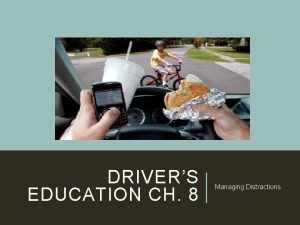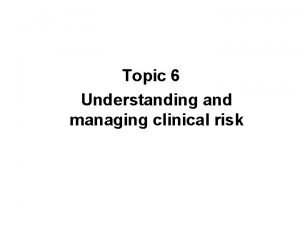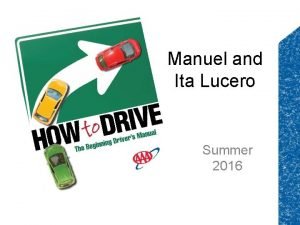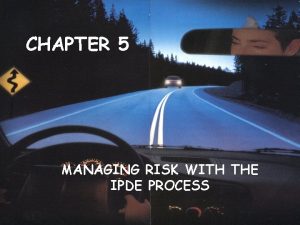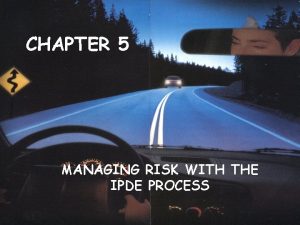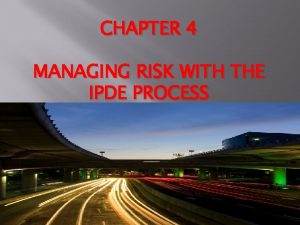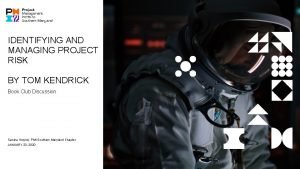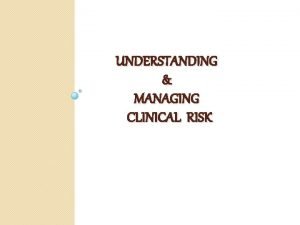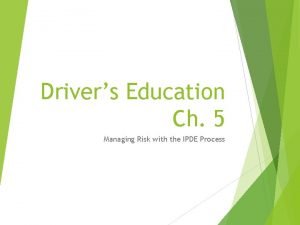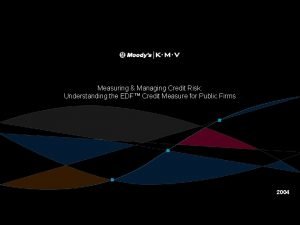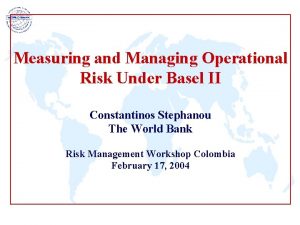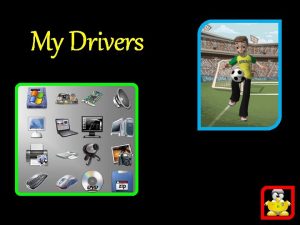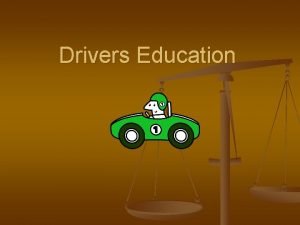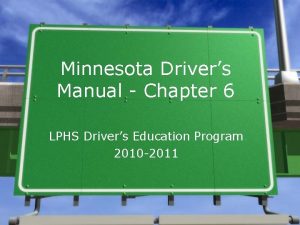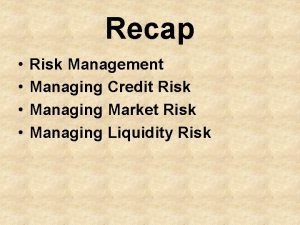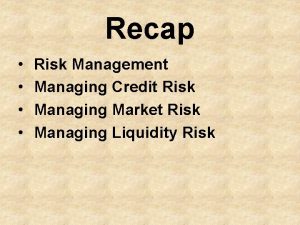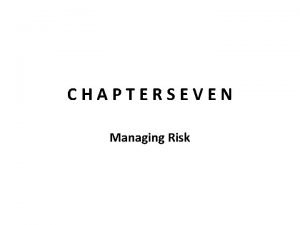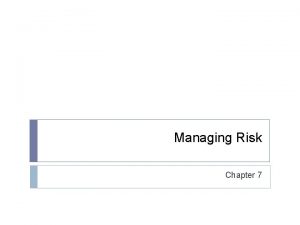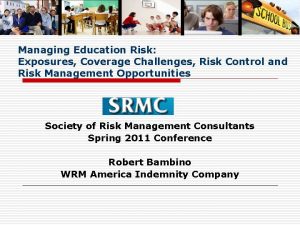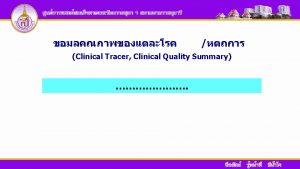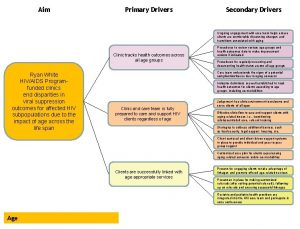Drivers Education Ch 5 Managing Risk with the






























- Slides: 30

Driver’s Education Ch. 5 Managing Risk with the IPDE Process

Ch. 5 Vocabulary Risk factors- IPDE Process- Identify- Predict- Decide- Execute- Zone- Open zone- Line of sight- Target area- Closed zone- Target area range- 4 -6 second range- 12 -15 second range- Orderly visual search pattern-

Ch. 5 Vocabulary Continued Field of vision- Depth Perception- Scanning- Ground viewing- Space cushion- Traction- Lane position 1 - Lane position 2 - Lane position 3 - Minimize a hazard- Compromise space- Maneuvers-

5. 1 The IPDE Process

Systems Drivers who use some kind of organized system will have less close calls and collisions. Good searching habits and the ability to manage space on the roadway are two basic tools for-low risk driving. All activities throughout a person’s life involve some degree of risk. Risk factors can be contributed by the driver, by the vehicle, by the roadway and environment.

Examples of driver contributed factors are: Adjusting radio Being angry Having blurred vision Combing hair while driving Putting on makeup Eating cereal AND USING A CELL PHONE!!!

Others Other drivers can increase or decrease your level or risk and chance of conflict Risks of ownership and responsibility of a car: Bald tires Poorly adjusted brakes Dirty windshield Broken headlights Worn wiper blades

There are contributing factors by the roadway and the environment: Bright sun Construction Dark shadows Snow and ice Sharp curves

Taking chances Safe driving depends on your ability to see and analyze traffic situations correctly. Driving is a thinking task. If a driver deliberately takes chances they not only put themselves but others at a high degree of risk. Good drivers make every effort to manage risk in order to lower the probability of conflict, and thus enjoy more stress-free driving.

2 systems for safe low risk driving The IPDE Process The Zone Control System Safe driving depends on upon your ability to see and analyze traffic situations correctly.

Habits Good seeing habits are the basic critical factors necessary for staying out of high-risk situations. The driving task is primarily a thinking task.

Which way are your habits going?

IPDE The IPDE process is an organized system of seeing, thinking, and responding. The four steps are Identify, Predict, Decide, and Execute. You begin the IPDE Process by “reading” traffic situations to gather information for your decisions and actions.

The Zone Control System The zone control system is an organized method for managing six zones of space surrounding your vehicle. The zone control system allows you to see and respond to changes in the traffic environment at a time when best control can be achieved. The structure of the zone control system includes the following steps: 1. See a zone change. 2. Check other zones. 3. Create time and space by getting the best speed control, lane position, and communication.

The IPDE Process Using the IPDE Process in conjunction with the Zone Control System will help you develop behaviors that will make you a safe and responsible driver. The identify and predict steps of the IPDE Process are critical in every driving environment. The first step of the IPDE Process is identify. A zone is one of the six areas of space around a vehicle that is the width of a lane and extends as far as the driver can see. An open zone is space where you can drive without a restriction to your line of sight or to your intended path of travel.

Vocabulary Terms Your line of sight is the distance you can see ahead in the direction you are looking. The target area is the section of the roadway where the target is located in the center of your intended path, and the area to the right and left. A closed zone is a space not open to you because of a restriction in your line of sight or intended path of travel, such as a red traffic light.

Searching your ranges The first searching range is the target area range, which is the space from your vehicle to the target area. Next you will search the 12 -15 second range, which is the space you will travel in during the next 12 -15 seconds. The 4 -6 second range is the space you will travel during the next 4 -6 seconds. The area you can see clearly and sharply is seen with your central vision. The area you can see to the left and right of central vision is your side vision, or peripheral vision.

Your Vocabulary Expanding An Orderly Visual Search Pattern is a process of searching critical areas in a regular sequence. Different driving environments and traffic situations present a variety of visual search patterns. The area you can see around you while looking straight ahead is called your field of vision. Depth perception is the ability to judge the relative distance of objects correctly. Scanning is glancing continually and quickly with very brief fixations through your orderly visual search pattern.

Ground Viewing is making quick glances to the roadway in front of your vehicle. A hill is an example of a line-of-sight restriction which could hide a closed zone as you go over the hill.

Predict Identify the roadway surface and condition each time you begin to drive. Once you have identified a hazard, predict how this hazard might affect your intended path of travel. When you predict, you interpret the information you have identified. You predict where possible points of conflict can occur.

Speed is Knowledge Speed is probably the most important factor in maintaining control of your vehicle. One basic part of your driving knowledge comes from the study of traffic laws and driver-education material. Making a judgment about a traffic situation involves measuring, comparing, and evaluating.

Traction The basic requirement for vehicle control is traction. Always try to judge and compare the possible consequences before deciding on the best action.

5. 3 Decide and Execute

Decide and Execute Once you have identified a situation and predicted a possible conflict, you then decide upon an action. Deciding like predicting is also a mental task. The last step of the IPDE Process is the Execute means that you carry out an action that you have decided upon. The area of space all around your vehicle is called space cushion.

Three parts of deciding Decide to change speed. Decide to change direction. Decide to communicate.

Moving lane positions Lane position 1 -car is centered within the travel lane. Lane position 2 - car is 3 -6 inches from the left line of the travel lane. Lane position 3 - car is 3 -6 inches from the right line of the center of travel.

Hazards You always want to minimize a hazard, or reduce the possibility of conflict by deciding to put more distance between yourself and the hazard. Separate the hazards is the process of adjusting the speed of a vehicle to handle one hazard at a time when two or more hazards threaten a driver. Compromise Space means reduce risk by giving as much space as possible to the greater of two or more hazards.

7 ways you can decide to communicate with others Headlights, tail lights, and brake lights. Turn signal lights. Parking lights and hazard flashers. Back-up lights. Horn. Car position. Eye contact and body movement.

Turn signals Maneuvers are actions you take while driving. You should turn on your turn signal three to five seconds before making any change in direction.

IPDE Remember that the IPDE Process takes time to put into action. Practice is necessary for the development of any skill.
 Credit risk market risk operational risk
Credit risk market risk operational risk Chapter 2 signs signals and roadway markings
Chapter 2 signs signals and roadway markings Chapter 8 managing distractions answers
Chapter 8 managing distractions answers Managing clinical risk
Managing clinical risk Chapter 1 managing risk when driving
Chapter 1 managing risk when driving Managing risk with the ipde process
Managing risk with the ipde process Ipde process examples
Ipde process examples Explain what is meant by selective use of the ipde process
Explain what is meant by selective use of the ipde process Module 4 topic 5 turnabouts and parking
Module 4 topic 5 turnabouts and parking Module 4 topic 1 assessing and managing risk
Module 4 topic 1 assessing and managing risk Module 7 managing risk answer key
Module 7 managing risk answer key Identifying and managing project risk tom kendrick
Identifying and managing project risk tom kendrick Lending policies and procedures managing credit risk
Lending policies and procedures managing credit risk Managing clinical risk
Managing clinical risk Managing property and liability risk
Managing property and liability risk Executing in the ipde process primarily involves
Executing in the ipde process primarily involves Chapter 4 managing risk with the ipde process
Chapter 4 managing risk with the ipde process Measuring and managing credit risk
Measuring and managing credit risk Basel ii event types
Basel ii event types Horizontal e vertical
Horizontal e vertical Risk projection
Risk projection Risk reduction vs risk avoidance
Risk reduction vs risk avoidance Absolute risk vs relative risk
Absolute risk vs relative risk Residual risk and secondary risk pmp
Residual risk and secondary risk pmp Ar = ir x cr x dr
Ar = ir x cr x dr Absolute risk vs relative risk
Absolute risk vs relative risk Activity sheet 2 stock market calculations answer key
Activity sheet 2 stock market calculations answer key Medium-term risk examples
Medium-term risk examples Risk financing transfer dan risk retention
Risk financing transfer dan risk retention The biggest risk is not taking any risk
The biggest risk is not taking any risk Fiduciary investment risk management association
Fiduciary investment risk management association


